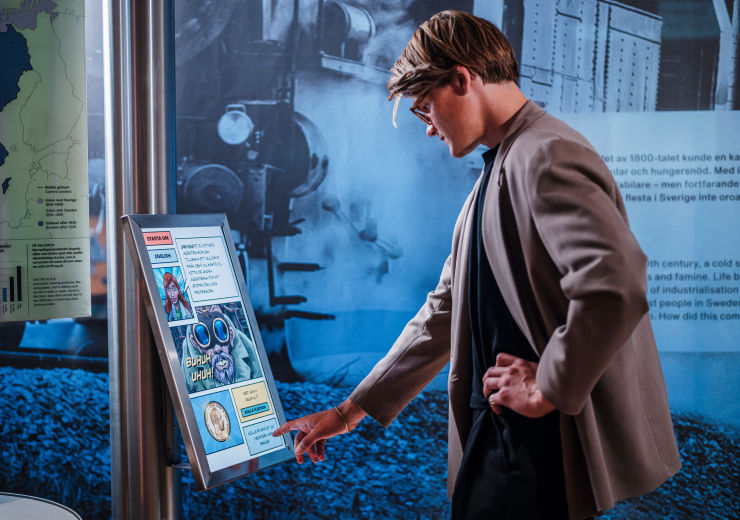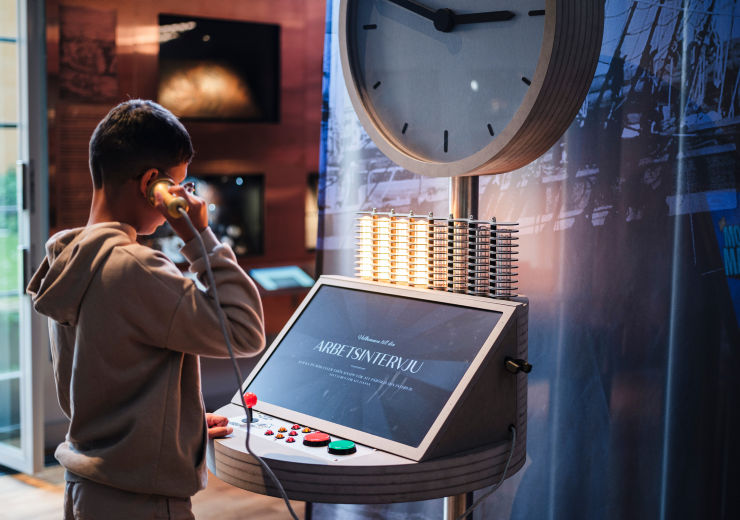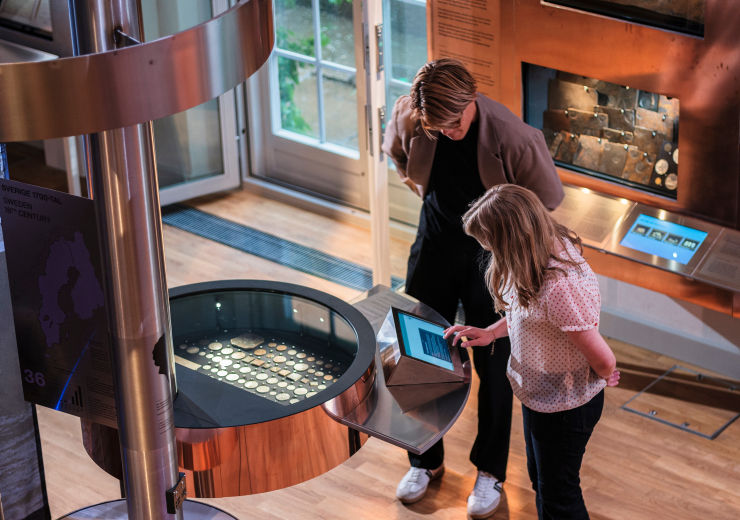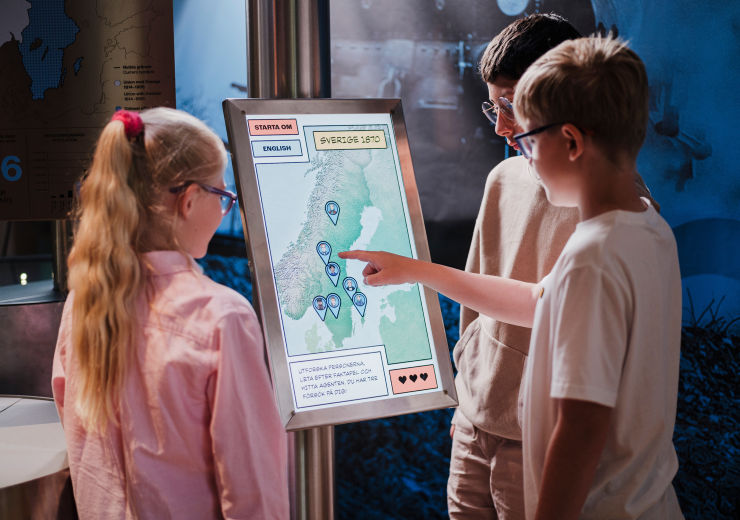
Creating digital solutions that engage various target groups in the museum world is a challenge. However, for the new permanent exhibition at the Economy museum, we have developed a strategy that meets visitors’ needs while efficiently utilizing resources. In the exhibition MONEY! we have developed digital products that not only work on-site but can also be used from home, both before and after a visit. This blog post focuses on how we identify the needs of our target groups and design digital content that creates a richer and more engaging experience.
A Flexible and Long-Term Strategy
Our strategy is built on the goal of reaching a wide range of visitors. Therefore, it is essential that our digital products are usable by those who visit the museum physically, as well as those who prefer to engage online, such as from home. By designing the content to be accessible through visitors’ own mobile devices or computers, we have created solutions that work equally well for those planning their visit, those on-site, and those who wish to explore the material afterward.
Teachers can also use these digital solutions as part of their teaching. By integrating them into lessons, students can interact with the material even if they are far from the museum. This is especially important for those who may never have the opportunity to visit the museum due to distance or other barriers. These products can therefore be used independently of a physical visit, which enhances accessibility beyond traditional museum experiences.
This flexibility allows us to maximize our efforts. By creating products that can be used over time, in different ways, and across various platforms, we can reach more people and make the material more accessible to a broader spectrum of visitors. We will take a closer look at four specific digital solutions used in the MONEY! exhibition: the game The Money Matrix, the job interview station, the object deep dive feature, and our audio guides.
The Money Matrix: Playful Learning through Time and Space
One of the most popular digital products in MONEY! is the game The Money Matrix. It is designed for a target audience of around 15 years old but can also be played by younger visitors together with a parent or another older person. Here, visitors travel back in time to try to identify a secret agent working for an evil professor to steal historical artifacts.
This game is a perfect example of how we use a game-based learning approach to convey historical and economic knowledge. By having players search for inaccuracies in the economic profiles of various fictional individuals from history, they absorb facts in a way that is both engaging and educational. This type of game-based learning is a powerful tool, especially for younger audiences, as it creates an interactive dynamic rather than simply passively receiving information.
The game is also designed to be accessible both on-site and digitally, allowing visitors to continue playing at home or prepare before their museum visit.
The Money Matrix is a gamification of real data. The characters in the game are fictional, but the prices, incomes, debts, and possessions featured in the game have been collected from sources such as probate inventories, archives, and literature by museum staff.
You can read more about the game here: https://ekonomiskamuseet.se/besok-oss/digitalt/money-matrix-en/
Or play directly on your mobile device or computer: https://appar.ekonomiskamuseet.se/money-matrix/

A kid listening to questions in the work interview station. Photo: Daniel Gustafsson, Economy Museum/SHM.
Job Interview Station: Humorous and Engaging
The job interview station is another example of how we create engagement by allowing visitors to experience history more personally. Through a touchscreen with levers where you can answer “yes” or “no” to questions, visitors simulate a job interview from the 1800s.
This station is also mainly aimed at a younger audience and offers a combination of realism and humor. The interview is strict, reflecting how harsh working conditions were at the time, but there is also a playful tone that makes the experience both informative and fun. This contributes to creating a sense of connection to history, where visitors can relate to the people who lived then and their life circumstances.
Like The Money Matrix, this solution is also accessible via mobile devices or computers, allowing visitors to dive into the content before or after their museum visit. The content is also based on historical sources.
Test which job you would have qualified for if you lived in the 1800s! https://appar.ekonomiskamuseet.se/arbetsintervjustationen

A couple looking at coins in a display case and using the object deep dive screen. Photo: Daniel Gustafsson, Economy Museum/SHM.
Object Deep Dive: Detailed Knowledge a Click Away
Another key feature in the PENGAR! exhibition is what we call the object deep dive. This is a series of touchscreens placed next to each display case, where visitors can click to access detailed information about specific objects. High-resolution images allow you to zoom in on small details, which is particularly valuable when it comes to coins and banknotes, the main object categories in the exhibition.
This system allows visitors to independently explore the exhibition’s content and gain a deeper understanding of the various objects. By offering this solution both on touchscreens and through mobile devices and computers, visitors can choose how and when they want to explore the material—before, during, or after a visit.
Want to learn more about how the object deep dive system works in other contexts? Check out the blog post The digital world of the Vikings, where this solution is explored in detail.
Explore the object deep dive for MONEY!: https://pengar.ekonomiskamuseet.se/

A visitor engaging in the exhibition with the help of our “digital companion”-device. Photo: Wilhelm Lagercrantz, SHM.
Audio Guides: Accessible for All
Our audio guides are a great example of how we work to make the exhibition accessible to more visitors, regardless of their needs. Audio guides can be borrowed as portable devices at the museum or used on visitors’ own mobile devices. We offer audio tracks in Swedish and English, as well as specially adapted versions for people with visual impairments and for those who are hard of hearing.
This solution not only creates a more inclusive experience but also enhances the flexibility of how visitors can engage with the exhibition.
Offering audio guides that can be used both on-site and online allows us to reach a wider audience and ensure that everyone, regardless of disabilities or language, can have a meaningful experience. This focus on accessibility is central to creating an inclusive museum experience.
Listen directly here: https://guide.ekonomiskamuseet.se/en
Educational Resource and Accessibility Beyond the Museum
Our digital solutions are not only important for visitors who are physically on-site. Teachers can use the solutions as part of their teaching, giving students the opportunity to interact with the content in meaningful ways, even if they are unable to visit the museum. This is especially valuable for schools located far from Stockholm.
The digital products are designed to function independently, so everyone can access the exhibition’s content without being physically present. This helps to broaden the museum’s reach, allowing more people to engage with our history and exhibitions. It also has PR value as it raises awareness of the museum and its offerings, potentially attracting future physical visitors.
In addition to the four products mentioned above, we have also curated content from the exhibition into an explore-section on the website, with a particular focus on SEO optimization. This is yet another way to extend our reach and maximize the impact of our efforts. https://ekonomiskamuseet.se/utforska/ (Swedish only)
The Whole Makes the Difference
It is through the combination of these digital solutions and the physical exhibition, with all its original objects and other interactive elements, that we can truly offer a rich and engaging experience. Each product is designed to meet the specific needs of different target groups, and together they create a holistic experience where visitors can engage with the material in various ways. Playful elements for younger visitors, detailed information for the more curious, and accessible solutions for people with disabilities create a complete experience.
With our solutions, we have created a model where accessibility, learning, and engagement are central. By offering flexible, long-term, and inclusive solutions that can be used both on-site and digitally, we have shown how digital tools can be used to engage and inform a broad audience.
The digital development work was carried out within an interactive and educational working group, which also developed the physical interactives. During the idea phase, we did not choose a format, instead letting the idea determine whether a physical or digital interaction was most appropriate. All products were developed in collaboration with our digital agency Bazooka and exhibition designer Ralph Appelbaum Associates.
All digital features can be accessed via a QR code on an introductory sign at the start of the exhibition or directly via this link: https://ekonomiskamuseet.se/en/visit/visit-us-digitally/
/Wilhelm Lagercrantz
Project Team, Swedish National Historical Museums
Florent Audy, Antiquarian
Linnea Ragnerstam Zetterberg, Museum Educator
Caroline Gonelius, Curator
Wilhelm Lagercrantz, Digital Strategist
Gösta Sandell, Curator
Other Project Contributors from the Swedish National Historical Museums
Felicia Sjölin, Intern
Albin Hedin, Antiquarian
Martin Machado Freeney, Intern
Jacob Fredriksson, Intern
Katarina Nimmervoll, Picture Curator
Pernilla Tenje, Exhibition Designer & Production Manager
Bazooka AB (Design, Illustrations, Programming)
Calle Stenfelt – UX and Illustrations
Micke Sonnenberg – Creative Designer
Hannah Andersson – Developer and Motion Design
Emil Hagbo – Developer
Emilia Anelli Windahl – Project Manager
Ebba Granat – Assistant Designer
Johannes Virtanen – Developer
Sussi Fichter – Interaction Design
Ralph Appelbaum Associates
Thomas Meyer
Johannes Bögle
